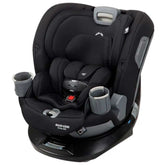6 Effective Ways to Help Turn a Breech Baby Naturally

When it’s time for deliver, the ideal position for a baby to be in is with its head down, also known as cephalic or vertex presentation. Babies who are positioned with the buttocks or feet to come out first when the due date rolls around are in what is known as the breech position. Usually, an infant will re-adjust and flip themselves over before the big day, but in about 3 to 4 percent of full-term births, this doesn’t happen on its own. In those instances, an obstetrician or midwife may use certain interventions to help rotate the infant. If these procedures don’t work, cesarean delivery may be the safest option.
Natural Ways to Help Turn a Breech Baby
There are a variety of natural ways to help a breech baby turn before they’re born, and some are more effective than others. Some techniques carefully ease the infant into the right place during the final weeks of gestation, while others are done by a healthcare provider at the hospital just prior to delivery.
It’s interesting to note that even if an infant is successfully repositioned into a vertex presentation, they will sometimes flip back to the feet/buttons down position. In addition, there isn’t a wide range of research on the effectiveness of many of these methods, though most of these techniques are low-risk, simple, and involve little discomfort.
1. Breech tilt exercise
With the breech tilt exercise, your body utilizes the force of gravity to get the baby to reposition. Easy enough to do in the comfort of your own home, this procedure involves elevating your hips above your heart level. One way to achieve this is by placing pillows under your hips while lying flat on your back on the floor or on a bed. Another option is to prop one end of an ironing board on the couch at a 30- to 40-degree angle and lie on it with your head facing downwards.
Perform this exercise three times a day, with each session lasting 10 to 15 minutes. Be careful, though, as this pose may cause dizziness. If you experience lightheadedness, discontinue the exercise and consult your healthcare provider before attempting it again.
2. Pelvic tilt and other positions
In some cases, the infant just needs a little space to turn around. In the pelvic tilt position, for example, the mother sways her pelvis backward and forward while in a hands-and-knees position. Lunging or kneeling leaning forward on one knee also may offer the baby a little more room for stretching out and flipping over. For those who practice yoga, consider trying the bridge pose for a similar result. Experiment to see what feels most comfortable for your body.
Various sleep positions may also help encourage the baby to turn. Side-sleeping with pillows stacked between your legs and supporting your body can open up your pelvic region, providing more space for the baby to get into the correct position.
During the later stages of pregnancy, swimming can be incredibly enjoyable and beneficial. The buoyancy offered by the water provides a sense of relief and can alleviate pressure on the body, creating additional space for the baby. The breaststroke and crawl can be particularly advantageous in encouraging the baby to reposition.
3. Acupuncture and moxibustion
Acupuncture involves the use of extremely thin, disposable needles inserted just beneath the skin. Its purpose is to release and facilitate the flow of qi (the vital life force according to Chinese medical principles), prevent blockages, and promote its movement throughout the body. By enabling the pregnant individual's body to move more freely and providing the necessary space within the uterus, this release of energy aims to assist the baby in finding a more optimal position for a successful birth.
Moxibustion, a practice rooted in traditional Chinese medicine, is performed by a trained practitioner. The practitioner burns a dried plant bundle known as a moxa stick over specific areas of the body. The purpose is to generate warmth and stimulate the flow of qi. By invigorating the qi, moxibustion aims to encourage the baby to move within the womb.
These interventions are often recommended by midwives and doctors, as they are generally non-painful and free from harmful side effects. While not backed by extensive empirical evidence, small-scale studies have indicated that these approaches could be equally effective compared to physically manually turning the baby.

4. Light and music
Babies in the womb can respond to certain stimuli, such as light and music. Utilizing these stimuli can potentially encourage the baby to reposition themselves. Try playing music or shining a flashlight near the pubic bone, as the baby may be drawn towards these stimuli and adjust their position accordingly.
To do this, start gradually by placing the music or flashlight at the side of your abdomen and then gradually move it towards the pelvis as the baby begins to shift. With music, use headphones to play the music at a volume that allows you to hear it when the headphones are placed near your pubic bone. This auditory stimulation may prompt the baby to move toward the sound. Begin by playing the music to the side of your abdomen and then gradually move it downward towards the pubic bone.
5. Heat and cold
Another method that may help guide the baby into position involves using heat and cold. The idea is to apply cold near the baby's current position (at the top of the uterus) and warmth where you want the baby's head to move (near the vagina). Even inside the womb, babies seek warmth and comfort, so any cold sensation near them will elicit a reaction and cause them to shift away. An effective tool for this technique is a bag of frozen peas or ice. For warmth, you can try taking a shallow bath that covers only the bottom half of your belly or use a warm pack. As the baby begins to shift, adjust the placement of the heat and cold to encourage them to move toward the pelvis. You can also try this method in conjunction with light and music stimuli. This method can be utilized as frequently as desired, but be sure to discontinue if it becomes uncomfortable.
6. Webster technique
The Webster technique is a chiropractic method that involves adjusting the body to promote the opening of the pelvis, loosening of ligaments, and alleviation of any tension that might be causing the pelvis to remain in a rigid and less accommodating position. By releasing this tension, the baby may have increased mobility to maneuver into a more favorable position. It is crucial to note that the Webster technique should only be performed by a qualified chiropractor who has received specialized training in this technique specifically for pregnant women.
Doctor Intervention: External Cephalic Version
External cephalic version (ECV) is a medical procedure done by a doctor or midwife. It is essential to have this procedure performed in a hospital setting due to associated risks, including placental abruption and umbilical cord prolapse. During the procedure, your healthcare provider will use their hands to apply pressure on the outside of your abdomen, aiming to encourage the baby to assume a vertex position. To help relax the uterus, medication is typically administered, and an ultrasound is used for guidance. It is worth noting that the force exerted during the procedure can cause discomfort or even pain. In cases of intense pain, an epidural may be recommended. Research indicates that external cephalic version is approximately 70% effective.

The Takeaway on Helping a Breech Baby Turn Naturally
Though it can be worrisome to discover that your baby is in a breech position, it is important to remember that in many cases, the baby will naturally reposition itself into a head-down position, either on their own or with the assistance of the interventions mentioned earlier. If these methods do not result in the baby turning, there is still a possibility, until delivery, for the baby to flip around.
If the baby cannot be turned from the breech position, the doctor will likely recommend a cesarean section, which generally carries a lower risk of complications. Waiting to see if the baby moves can be anxiety-inducing, frustrating, and stressful. However, regardless of how your baby is born, the most significant aspect of childbirth remains the same—the arrival of the precious baby you will soon be cradling in your arms.
Disclaimer: The information on our site is NOT medical advice for any specific person or condition. It is only meant as general information. Please contact your health provider if you have any medical questions or concerns about your child or yourself.










